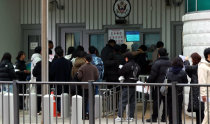Bach Visit

On the afternoon of June 8 in Nagoya, Aichi Prefecture, more than 2,000 spectators were packed into the concert hall of the citys arts theater, though it was daytime on a Saturday. They were crowding the hall to watch and listen to the Brandenburg concertos performed by the oldest orchestra in the world, the Leipzig Gewandhaus Bach Orchestra from Germany, which was established in 1743.
Should football be played with 22 balls, all of the players could be happy, but as we know, theres only one. However, the spectators are entertained for that. Likewise, an orchestra is similar to soccer in that the performers entertain the audience by creating a single harmony.
Prof. Christian Funke (First Violin), who had just conducted the orchestra through the six Brandenburg concertos, greeted me with a smile and began his talk with World Cup football issues. On July 19 at eight in the evening at the Seoul Arts Center he will once again lead his orchestra, which will have their first concert on a Korean stage.
The Bach Orchestra is consisted of soloists (leaders and deputy leaders) of each part of the Leipzig Gewandhaus Orchestra, which has special ties to Johann Sebastian Bach. Following the tradition established while Mendelssohn was conducting between 1835 and 1847, the orchestra is devoting itself to reinterpreting and performing Bachs works.
Condensing various concerto styles from the baroque era, the Brandenburg concertos are rarely performed in a day since it requires tough techniques and stamina. The members, however, have shown off admirable skills, playing their repertories all the way standing for two hours. Their explanation is that soloists usually perform on their feet.
Although they didnt play original scores which is a style in vogue that performs with restored instruments and fashion from the time they were originally played, they let the audience enjoy Bachs works reinterpreted according to their tradition. The tempo and vigor of their music was similar to pop, while the elegance and clearness of the genuine repertories were preserved.
However, there were some imperfect features in the performance as well. Due to the use of a modern instrument, horns, instead of baroque trumpets, Concerto No.2 lacked brilliance. The sound of cembalos, an old instrument, was buried under sounds of modern instruments.
Funke said, Bach wrote the notes, not descriptions on where to use which instrument or how to play them. Because trumpets from Bachs era were very high-toned, its very difficult to play original trumpets. Thats why we need interpretations of Bach of our own.
In addition to the performance on July 19, the Bach Orchestra will have another concert at 8:00 p.m. on July 20 at Nowon Culture and Art Center in Seoul. Among the repertories are Bachs Air on a G String, Pachelbels Canon, Handels Largo, and Albinonis Adagio. For further information, call 02-599-5743.
Seung-Hoon Cheon raphy@donga.com




![라면 5만 개 끓여 보며 성능 테스트… “무인점 라면 조리기 95% 차지”[유레카 모멘트]](https://dimg.donga.com/c/138/175/90/1/wps/NEWS/IMAGE/2025/12/27/133042718.4.jpg)

![“이걸 어떻게 피해” 잘 가는데 날벼락…7:3 과실비율 논란 [e글e글]](https://dimg.donga.com/c/138/175/90/1/wps/NEWS/IMAGE/2025/12/26/133042068.3.jpg)
